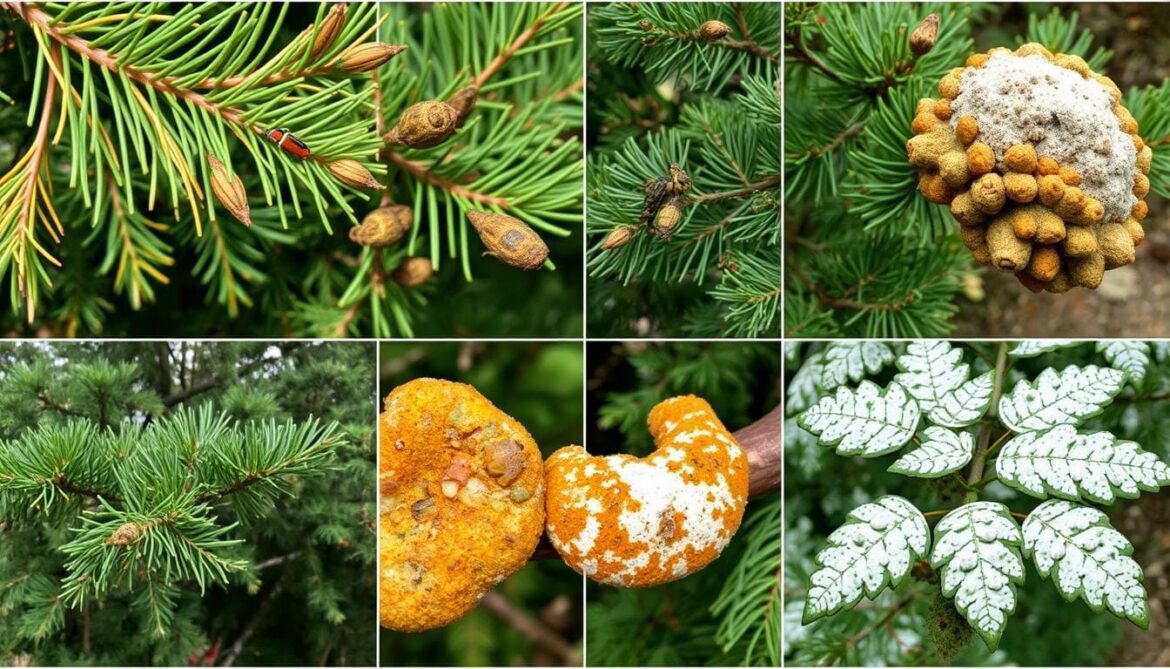As autumn arrives, we admire the evergreen trees that stand tall. They provide a sense of life that lasts through the seasons. But, these trees face diseases that threaten their health.
From the seasonal needle drop to fungal infections, evergreen trees face many challenges. Knowing about these diseases helps us protect them. We can keep these trees healthy for future generations.
Key Takeaways
- Evergreen trees, including pines, cypresses, junipers, and cedars, are susceptible to various diseases like seasonal needle drop, Rhizosphaera Needle Cast, Cytospora Canker, and Diplodia Blight.
- Regular inspection for discoloration, wilting, or unusual growth patterns is crucial for early detection and treatment of these diseases.
- Environmental conditions, such as moisture, humidity, and tree stress, can contribute to the spread and severity of these diseases.
- Understanding the symptoms and causes of common evergreen tree diseases is essential for maintaining the health and longevity of these vital members of our urban landscapes.
- Proactive care and management, including proper watering, soil maintenance, and seeking professional help when needed, can help prevent and mitigate the impact of these diseases.
Introduction to Evergreen Trees Diseases
Keeping our evergreen trees healthy is a big responsibility we all have. Knowing the common diseases they face is the first step. These diseases can harm the tall pines and the tall firs, from fungal infections to bugs.
Importance of Understanding Diseases
Learning about common evergreen tree diseases helps us spot problems early. Early action stops diseases from spreading and keeps our trees healthy. Knowing signs of dwarf mistletoe and white pine blister rust is crucial for our trees’ health.
Overview of Common Diseases
- Cytospora Canker
- Rhizosphaera Needle Cast
- Bagworm
- Cercospora Blight
- Diplodia Blight
- White Pine Weevil
These diseases hit many evergreen types, like spruce, pine, and juniper. They cause needle color changes, branch death, and tree decline.
How Diseases Affect Evergreen Trees
Diseases can harm evergreen trees a lot, affecting their health and look. They can turn needles brown and weaken the tree. Knowing how diseases work helps us prevent and treat them.
“Evergreen trees will hold on to several years’ worth of growth and only lose the oldest leaves.”
Symptoms of Evergreen Trees Diseases
It’s important to spot early signs of disease in evergreen trees to keep them healthy. Look out for leaf discoloration, bark damage, and stunted growth.
Leaf Discoloration
Leaf discoloration is a clear sign of disease. You might see yellowing, browning, or even tri-colored needles. Fungi like Lophodermium, Cyclaneusma, and Ploioderma can turn last year’s needles reddish-brown or purple before they fall.
Other diseases, like Rhizosphaeria needle cast, cause yellow and reddish-brown spots on needles.
Bark Damage
Diseases can harm the bark of evergreen trees, causing cankers and cracks. The Crytospora Canker affects Colorado blue spruce and Norway spruce, and also hits hemlocks, larches, Douglas fir, and balsam fir. If not treated, these cankers can kill branches and even the whole tree.
Stunted Growth
Healthy evergreen trees grow well and consistently. Stunted needles, “witch’s brooms,” or dieback of lower branches and tips are signs of disease. Pycnidia, small black fruiting structures, on affected areas also point to fungal infections.
Spotting the symptoms of evergreen tree diseases is key to diagnosing and treating them. Regular checks and quick action can help keep your trees healthy.
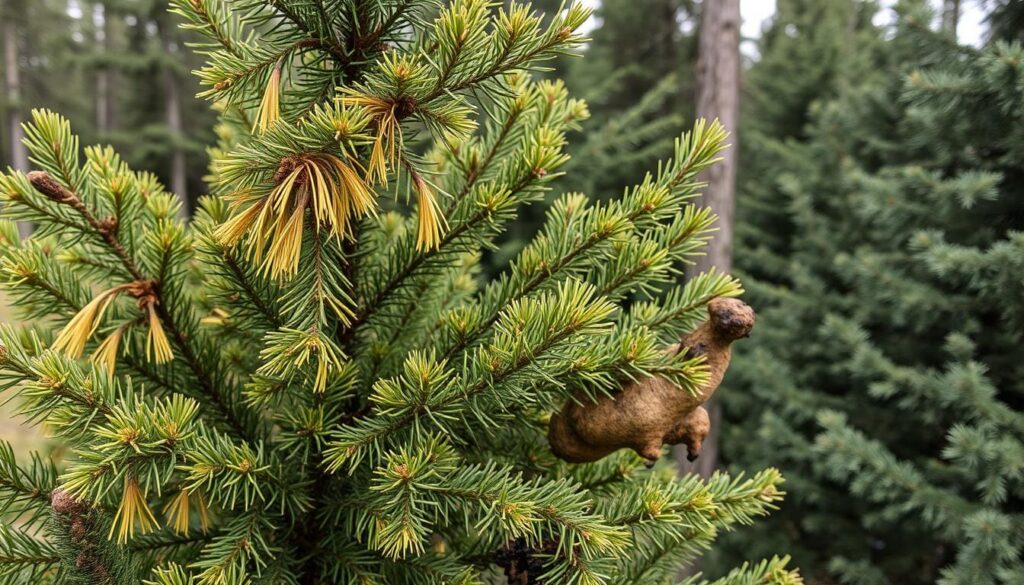
Fungal Diseases Affecting Evergreen Trees
Evergreen trees can get sick from many fungal diseases. These diseases don’t usually kill trees fast but can make them look bad. It’s important to know about these diseases to keep our trees healthy and looking good.
Needle Cast
Rhizosphaera Needle Cast is a common disease. It makes needles turn color and fall off, starting at the bottom. It likes wet weather and can get in through cuts or when trees are stressed. Using chlorothalonil or copper fungicides in early spring can help stop this disease.
Root Rot
Root Rot is a serious disease that can be hard to treat. It often means the tree needs to be removed. This disease weakens the roots, making trees more susceptible to other problems. To help, treat the soil well and fertilize deeply.
Cankers
Fungal cankers, like Diplodia Blight, can harm trees. They cause stunted needles and branch death. Using thiophanate methyl or propiconazole can control this disease for a long time. Cutting back affected trees can also stop the spread of spores.
Talking to a tree expert is key to treating fungal diseases. They can help choose the right treatments and care for our trees. This way, our trees stay healthy and beautiful for a long time.
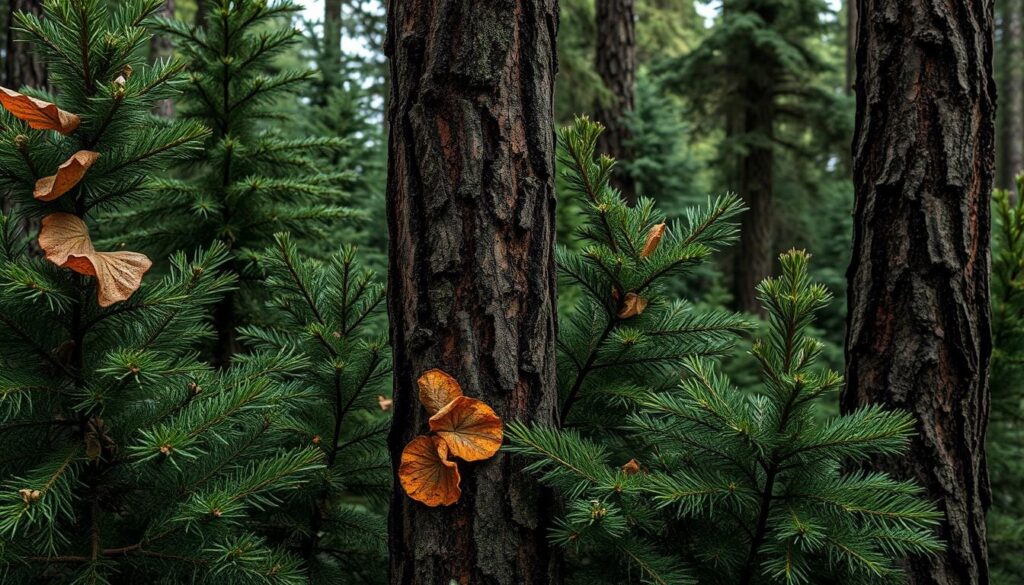
Bacterial Diseases in Evergreen Trees
Bacterial infections can harm evergreen trees just like fungal diseases. These infections can cause needle blight and make trees sick. It’s important to know how these diseases affect our favorite conifers.
Pine Needle Blight
Pine needle blight is a common problem. It’s caused by bacteria that turn pine needles brown and wilted. Trees can look bad and lose needles as the disease spreads.
Bacterial Blight
Bacterial blight is another issue for evergreen trees. It affects many types, like spruces and firs. The disease makes needles turn brown and die, weakening the tree.
Effects on Tree Health
Bacterial diseases can really hurt evergreen trees. They make trees look bad and lose needles. They also stop trees from growing well. In the worst cases, trees can get even sicker and die.
We need to watch out for these diseases to keep our evergreen trees healthy. Knowing the signs and how to prevent them helps keep our trees strong and beautiful.
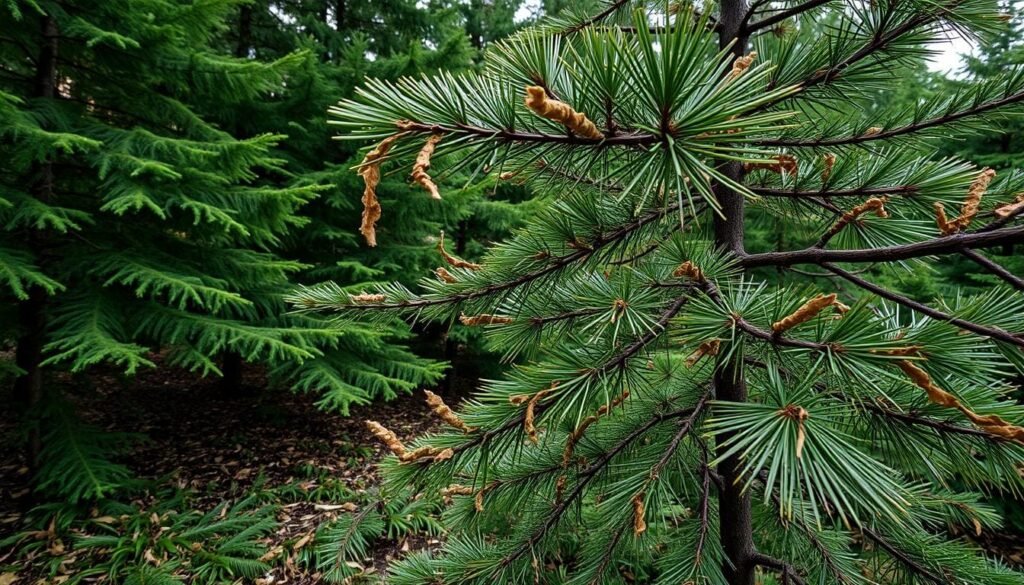
Insect-Related Problems for Evergreen Trees
Evergreen trees can face many insect problems. These pests can harm their health and look. Knowing the common pests helps us protect our spruce, pine, and fir trees.
Bark Beetles
Bark beetles are a big worry for pine and spruce trees. They bore into the bark, harming the tree’s flow and introducing fungus. A single tree can have over 100 beetles, spreading fast.
Aphids
Aphids are common pests on evergreen trees. They suck sap, weakening the tree. This can cause stunted growth and yellowing. Spruce spider mites are especially harmful to certain spruce trees.
Scale Insects
Scale insects, like pine needle scale, are a big problem. They attach to needles or bark, draining the tree’s resources. Heavy infestations can kill the tree.
To fight these pests, we must watch our trees closely. We should act fast if we see any signs of pests. Using the right treatments and working with arborists can help keep our trees healthy.
| Pest | Affected Trees | Damage | Treatment |
|---|---|---|---|
| Bark Beetles | Pine, Spruce | Bores through bark, introduces blue-stain fungus | Insecticides, Sanitation |
| Spruce Spider Mites | Spruce (especially Colorado blue, Norway) | Causes stippling, needle drop, webbing | Miticides, Horticultural oils |
| Pine Needle Scale | Conifers | Sap-feeding, branch dieback, tree mortality | Insecticidal soaps, Horticultural oils |
By being proactive, we can protect our evergreen trees from pests like spruce budworm and white pine blister rust.
Environmental Factors Contributing to Diseases
We must know how the environment affects evergreen trees’ health. These trees face many challenges, like poor soil and climate change. These issues can make them sick.
Poor Soil Conditions
Evergreen trees, like white pines, have a hard time in heavy clay soils. These conditions can cause root rot and nutrient shortages. This makes them weak and more likely to get sick, like sudden oak death.
Overwatering Risks
Too much water is bad for evergreen trees too. Waterlogged soils can hurt roots and cause trees to grow poorly. They may turn yellow and get fungal infections. It’s important to manage water well to keep these trees healthy.
Impact of Climate Change
The changing climate affects evergreen trees’ diseases too. Weather changes can damage trees in winter. Warmer temperatures and different rain patterns help pests and diseases grow. We need to find new ways to protect our evergreen trees as the climate changes.
Knowing how the environment affects evergreen trees helps us fight diseases. We can take steps to keep these important trees healthy for a long time.
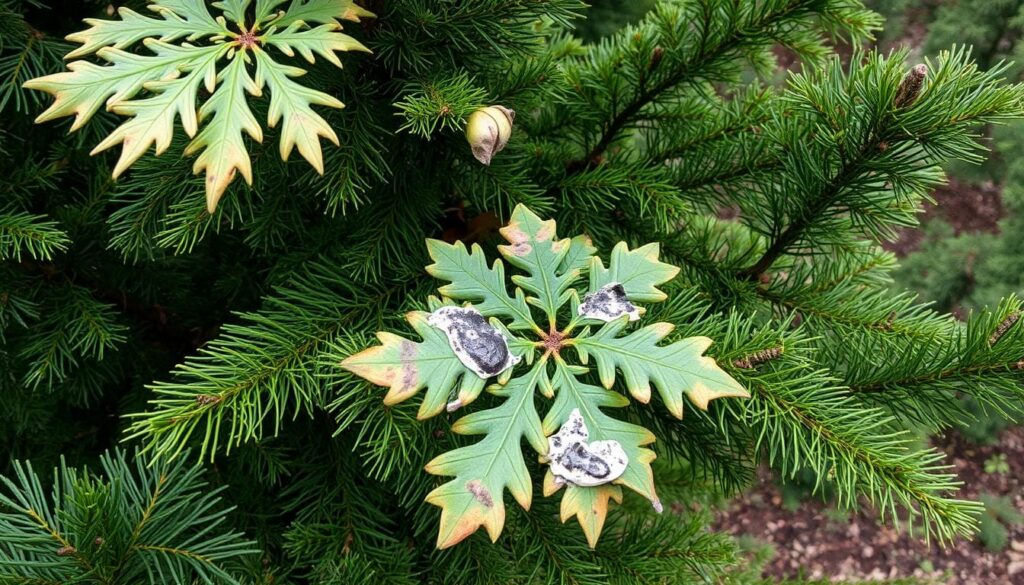
Common Evergreen Tree Species Affected
Evergreen trees face many diseases that can harm their health and lifespan. Spruce, pine, and fir trees are often affected. Knowing which trees are most at risk helps us protect them better.
Spruce Trees
Spruce trees, like the Colorado spruce and Norway spruce, are hit by Cytospora Canker and Rhizosphaera Needle Cast. Cytospora Canker spreads fast when spruce trees are stressed. Rhizosphaera Needle Cast can spread to healthy trees through the air.
Pine Trees
Pine trees are common in many landscapes but often get sick. They can get Diplodia Blight, Pine Wilt, and White Pine Weevil. Diplodia Blight spreads through wounds and thrives in warm, humid places.
Fir Trees
Fir trees, with their tall, pyramid shapes, face many problems. They can get Cytospora Canker, Fir Blight, and Adelgids. Keeping fir trees healthy is key to fighting these issues.
Knowing the specific dangers to these evergreen trees helps us protect them. This way, we can keep them safe from cypress canker, dutch elm disease, and other threats.
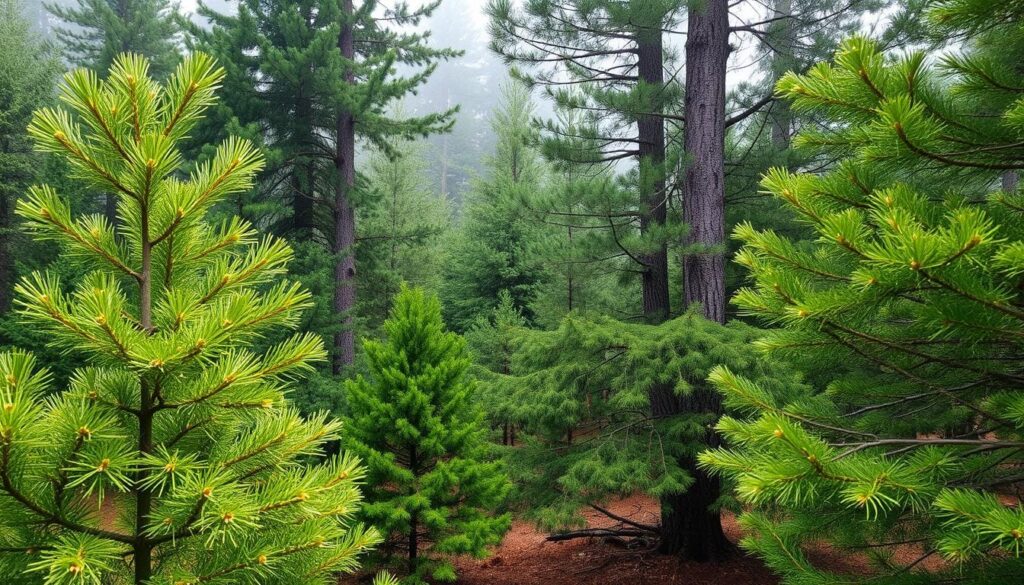
Preventative Measures for Tree Health
To keep evergreen trees healthy, we need to act early. By taking the right steps, we can fight off common evergreen trees diseases. This helps our trees stay strong and beautiful in our gardens.
Proper Watering Techniques
Evergreen trees need the right amount of water. Too much can harm them. We should water them based on their type, the weather, soil, and how fast they grow. Good watering habits can stop problems like pine wilt disease and others.
Soil Management Strategies
The health of a tree’s roots is key to its health. We can make the soil better for trees by testing it, adding nutrients, and making sure water drains well. This stops water from causing root rot.
Regular Tree Maintenance
Keeping up with tree care is important. We should check for pests or diseases, trim bad branches, and use pest control methods. Regular tree care helps prevent and handle evergreen trees diseases.
“An ounce of prevention is worth a pound of cure when it comes to tree health. By taking proactive steps, we can safeguard our evergreens and ensure they continue to thrive for years to come.”
By focusing on watering, soil care, and regular maintenance, we can stop and manage evergreen trees diseases. With a complete tree care plan, our evergreens will stay healthy, lively, and strong for many years.
Treatment Options for Evergreen Tree Diseases
Keeping our evergreen trees healthy is a big job. We use many ways to fight off diseases. This includes chemical treatments, organic methods, and good tree care.
Chemical Treatments
For pests like bagworms, we use insect sprays early on. Fungicides like copper hydroxide help fight fungal diseases. These diseases affect trees like pine and spruce.
Organic Solutions
Many prefer natural ways to fight diseases. Cutting off sick parts helps slow disease spread. Good soil and air around the tree also help.
Cultural Practices
Good tree care is key to fighting diseases. Watering right, pruning well, and feeding the tree help. This keeps trees strong against many diseases.
Some diseases, like Pine Wilt, are tough to beat. But early action and the right treatment can help. This keeps our trees looking great and healthy.
Recognizing When to Seek Professional Help
As fans of evergreen trees, we must watch for disease signs. Some minor problems can be fixed at home. But, sometimes, we need a pro’s help. Spotting serious damage early helps us tackle tree health issues before they get worse.
Signs of Advanced Damage
Seeing a lot of branch death is a clear sign of disease spread. If big parts of your white pine or spruce trees are dying from white pine blister rust or spruce budworm, act fast. Look out for severe needle loss, color changes, and fungal growths too.
Consulting an Arborist
If home fixes don’t work or diseases get worse fast, see a certified arborist. They know how to figure out the problem and suggest the best fix. Arborists can also teach you how to keep your evergreens healthy for a long time.
Local Extension Services
- Your local extension service is a great help for tree diseases in your area.
- They can give advice on treatments, like organic or chemical options.
- They also offer workshops and materials to teach you about caring for evergreen trees.
By watching for serious damage and getting help when needed, we can keep our evergreen trees healthy. Early action is crucial to keep their beauty and benefits for us and nature.
Case Studies: Successful Recoveries
Restoring evergreen trees to health is a tough journey. Yet, many trees have made a full recovery. Learning from these successes helps us protect our sudden oak death and cypress canker trees better.
Recovery of Diseased Pines
In a small community, a pine needle blight outbreak was tackled by arborists and residents. They quickly identified the disease and started a treatment plan. This plan included pruning, fungicides, and better soil care.
After a year, the pines were green and strong again. This shows how teamwork and quick action can save trees.
Treatment of Spruce Trees
A neighborhood in the Pacific Northwest faced a cypress canker outbreak. The community came together to save their spruce trees. They detected the disease early, pruned affected branches, and used organic fungicides.
Thanks to their efforts, the trees recovered and thrived. This story highlights the value of caring for evergreen trees proactively.
Community Education Efforts
In a forested area, local authorities knew education was key. They held workshops and shared resources on tree diseases. This helped residents protect their trees.
As a result, the trees’ health improved. People now understand the importance of tree care.
These stories show that even sick evergreen trees can recover. With knowledge, quick action, and community support, we can keep our trees healthy for years to come.
Conclusion: Ensuring Our Evergreens Thrive
We’ve looked at diseases and challenges facing our evergreen trees. It’s clear we must be vigilant and take care of them. Regular checks, proper care, and acting fast are key to fight diseases like dutch elm disease and others.
Importance of Vigilance
Being watchful helps us spot problems early. This way, we can fix issues before they get worse. Regular checks on our evergreen trees help us keep them healthy.
Encouragement for Tree Care
Tree care needs dedication to their needs. We must water, prune, and control pests properly. Our efforts help these trees stay healthy for a long time.
Collective Responsibility for Health
Keeping our evergreen trees healthy is a job for everyone. We need community help in learning about tree care. Together, we can protect these trees for future generations.
